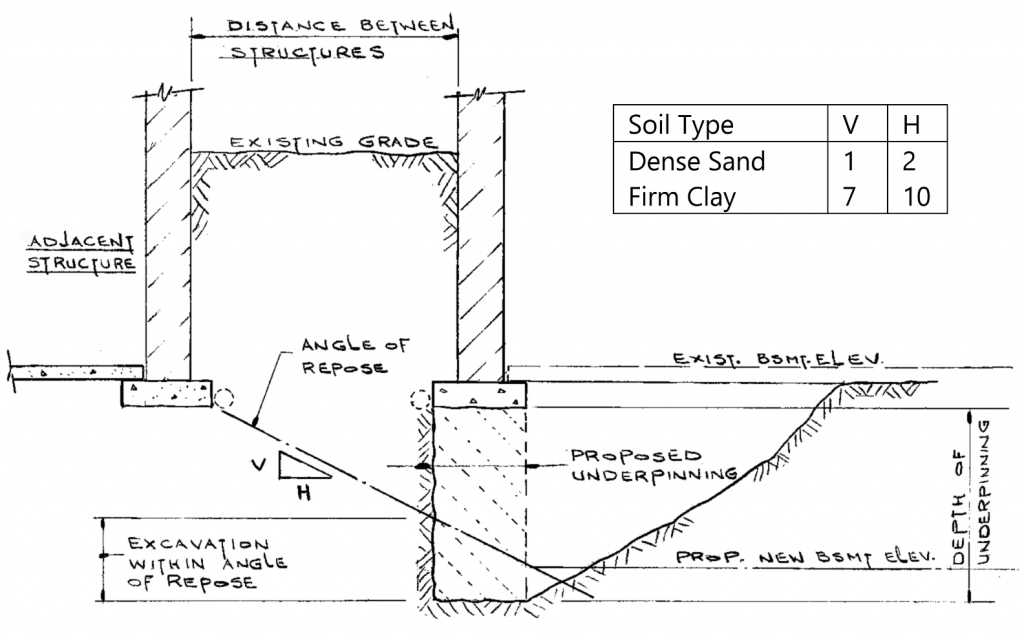
Building Permit for underpinning of the foundation of an existing house.
Building Permit
Underpinning is a method of increasing the depth of an existing foundation by constructing new footings beneath the existing footings. One may also underpin to reinforce an existing foundation or to add a below grade or partly below grade entrance to an existing house.
The angle of repose is the maximum angle (measured from the horizontal) where the soil will remain stable. This angle varies depending on the soil conditions. The sketch below provides some guidelines to use with two common soil types. If your construction will exceed these guidelines or if the soil type is unknown, consult a professional to prepare your design drawings. Disturbing the soil anywhere within the angle of repose could lead to soil failure and result in serious and difficult to repair consequences.

A foundation shall be designed and reviewed on-site by a Professional Engineer when it is constructed below the level of the footing of an adjacent building and within the angle of repose of the soil. Your designs must be sealed by a Professional Engineer, your Engineer must sign the Commitment to General Reviews form, and the completed Commitment to General Reviews (including Part A to be completed by the Owner) must be submitted with your permit application.
Please note: In all circumstances of underpinning, whether the underpinning was required to be designed by a Professional Engineer or not, you will be required (at the minimum) to provide testing and reports by a Professional Engineer during the first and last stages of the construction in order to pass inspections.
All drawings to be drawn on standardized sized sheets, drawn to scale, fully dimensioned, signed and dated.
Applications including drawings with the seal of a professional engineer must include a completed Assumption of Responsibility for Engineering Content Form.
If drawings were prepared by a qualified designer (as defined under Div. C, Part 3, Section 3.2 of the Ontario Building Code), drawings must include the designer’s name, registration number, qualification identification number, signature, and stamp/statement that the person has reviewed and taken responsibility for the design activities.
All drawings, reports, and forms, including the completed Application for a Permit to Construct or Demolish, must be provided in a PDF format.
Application to Construct or Demolish Form
Building permit application form required for all submissions
Schedule 1: Designer Information Form
Required for all designers, except Engineers and Architects when applying for any Construction Permit. Property Owners, if exempted from Qualification/Certification, must fill-in the form to specify the reason for exemption.
Assumption of Responsibility for Engineering Content Form
Where the permit drawings and/or documents submitted with a building permit application for a design of a new house or material alteration to an existing house bear the seal of a professional engineer, the professional engineer who sealed drawings and/or documents shall confirm the content for which the engineer is assuming professional responsibility by completing the Assumption of Responsibility for Engineering Content Form.
Commitment to General Reviews by Architect and Engineer
Professional design and field review is required where the foundations of a of a building are to be constructed below the level of the footings of an adjacent building and within the angle of repose of the soil, or the underpinning exceeds 1200 mm of Laterally unsupported height, or the soil is clay or silt. This Commitment form must be signed by the owner or agent and the professional architect, engineer, or consultant.
Required for all projects where there is a potential for damage to private or City trees. Applicant is also responsible to comply with other tree protection bylaws.
To submit an application by email please use the ‘Email’ button on top of the Application for a Permit to Construct or Demolish.
Detailed steps for the email submission process are also available to assist in making your application.
| Fee Effective Jan. 1, 2025 | |
|---|---|
| Underpinning | $11.89/linear metre |
Please DO NOT include any personal information on your Building Plans (e.g., the homeowner’s name or phone number). Building Plans submitted for Permit are subject to public disclosure in accordance with the Municipal Freedom of Information and Protection of Privacy Act (MFIPPA).